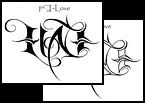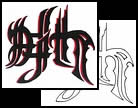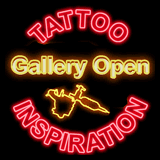|
TATTOO DESIGNS & SYMBOLS - AMBIGRAM TATTOOS
Tattoo Symbol Index -
A
B
C
D
E
F
G
H
I
J
K
L
M
N
O
P
Q
R
S
T
U
V
W
X
Y
Z
Tattoo designs - A >> Ambigram Tattoos
 Ambigram Tattoo Meanings
- An increasingly popular motif in tattoo parlours is the ambigram -- a graphic figure that can be flipped, mirrored or inverted, yet whichever way the script or the figure is viewed, it still spells out the same thing. It is sometimes referred to as an 'inversion' or 'flipscript', but regardless of the description, most people appreciate it as an optical illusion. The shifting positive and negative spaces can play tricks on our visual perception, casting a spell on the beholder. Ambigram Tattoo Meanings
- An increasingly popular motif in tattoo parlours is the ambigram -- a graphic figure that can be flipped, mirrored or inverted, yet whichever way the script or the figure is viewed, it still spells out the same thing. It is sometimes referred to as an 'inversion' or 'flipscript', but regardless of the description, most people appreciate it as an optical illusion. The shifting positive and negative spaces can play tricks on our visual perception, casting a spell on the beholder.
|
|
For tattoo aficionados, there's a dictionary of ambigram designs to choose from, and a great range of scripts and fonts, from simply elegant to graphically gothic. A design may consist of a single word or an entire phrase. Depending on the ambigram's concept, it can be rotated, reversed, or reflected in mirrors, with the meaning sometimes changing, sometimes remaining the same. Looked at one way, you might see a devil, but turn it around and an angel appears, or at least the way the figure is spelled! |
The best tattoo artists can create an optical illusion with an intriguing graphic design that never fails to intrigue.

According to practitioner John Langdon, ambigrams were independently
invented by himself and by Scott Kim in the 1970s. Kim used the name
Inversions as the title of his first collection in 1981. The first
published reference to "ambigram" was by Hofstadter, who attributes
the origin of the word to conversations among a small group of
friends during 1983-1984. The 1999 edition of Hofstadter's Gödel,
Escher, Bach features a 3-D ambigram on the cover.
John Langdon is truly one of the great ambigramists, his work appearing on the covers of some recent best-selling books. Popularity of the ambigram soared when they were intertwined into the plot of Dan Brown's bestseller 'Angels and Demons', the prequel to The Da Vinci Code.
Langdon produced ambigrams
that were used for the book cover, and a link to his website from
Brown's meant he was "suddenly inundated" with commissions. In fact
the name Robert Langdon (the hero from the novel) is also an
appreciation to Mr. John Langdon.
 Ambigrams are popular with graphic artists, due not only to their unique symmetry but to their mysterious quality so readily appreciated on music albums and book jackets. Paul McCartney is but one of many rock musicians who have featured an ambigram on at least one of his albums. Ambigrams are popular with graphic artists, due not only to their unique symmetry but to their mysterious quality so readily appreciated on music albums and book jackets. Paul McCartney is but one of many rock musicians who have featured an ambigram on at least one of his albums.
Many people choose to get an ambigram tattoo on their forearm, where they can flip it one way or the other, giving viewers the full effect of the design.
Ambigrams usually fall into one of several categories:
Rotational
A design that presents several instances of words when rotated
through a fixed angle. This is usually 180 degrees, but rotational
ambigrams of other angles exist, for example 90 or 45 degrees. The
word spelled out from the alternative direction(s) is often the
same, but may be a different word to the initially presented form. A
simple example is the lower-case abbreviation for "Down", dn, which
looks like the lower-case word up when rotated 180 degrees.
Mirror
A design that can be read when reflected in a mirror, usually as the
same word or phrase both ways. Ambigrams that form different words
when viewed in the mirror are also known as glass door ambigrams,
because they can be printed on a glass door to be read differently
when entering or exiting.

Figure-ground
A design in which the spaces between the letters of one word form
another word.
Chain
A design where a word (or sometimes words) are interlinked, forming
a repeating chain. Letters are usually overlapped meaning that a
word will start partway through another word. Sometimes chain
ambigrams are presented in the form of a circle.
Space-filling
Similar to chain ambigrams, but tile to fill the 2-dimensional
plane.
Fractal
A version of space-filling ambigrams where the tiled word branches
from itself and then shrinks in a self-similar manner, forming a
fractal. See Scott Kim's fractal of the word TREE for an animated
example.
3-dimensional
A design where an object is presented that will appear to read
several letters or words when viewed from different angles. Such
designs can be generated using constructive solid geometry.
Perceptual shift
A design with no symmetry but can be read as two different words
depending on how the curves of the letters are interpreted.
Natural
A natural ambigram is a word that possesses one or more of the above
symmetries when written in its natural state, requiring no
typographic styling. For example, the words "dollop" and "suns" are
natural rotational ambigrams. The word "bud" forms a natural mirror
ambigram when reflected over a vertical axis. The words "CHOICE" and
"OXIDE", in all capitals, form a natural mirror ambigram when
reflected over a horizontal axis. The word "TOOTH", in all capitals,
forms a natural mirror ambigram when its letters are stacked
vertically and reflected over a vertical axis.
Symbiotogram
An Ambigram that, when rotated 180 degrees, can be read as a
different word to the original.
A portion this
article is licensed under the
GNU
Free Documentation Licensee.
For more see the Wikipedia article
http://en.wikipedia.org/wiki/Ambigram
 Ambigrams are exercises in graphic design that play with optical
illusions, symmetry and visual perception. Ambigram lovers value
especially those with a relation between form and content. Ambigrams are exercises in graphic design that play with optical
illusions, symmetry and visual perception. Ambigram lovers value
especially those with a relation between form and content.
Get inspired by some really great images and photos in our Ambigrams
Inspiration Gallery
Tattoo designs - A >> Ambigram Tattoos
Tattoo Symbol Index -
A
B
C
D
E
F
G
H
I
J
K
L
M
N
O
P
Q
R
S
T
U
V
W
X
Y
Z
|




 Ambigram Tattoo Meanings
- An increasingly popular motif in tattoo parlours is the ambigram -- a graphic figure that can be flipped, mirrored or inverted, yet whichever way the script or the figure is viewed, it still spells out the same thing. It is sometimes referred to as an 'inversion' or 'flipscript', but regardless of the description, most people appreciate it as an optical illusion. The shifting positive and negative spaces can play tricks on our visual perception, casting a spell on the beholder.
Ambigram Tattoo Meanings
- An increasingly popular motif in tattoo parlours is the ambigram -- a graphic figure that can be flipped, mirrored or inverted, yet whichever way the script or the figure is viewed, it still spells out the same thing. It is sometimes referred to as an 'inversion' or 'flipscript', but regardless of the description, most people appreciate it as an optical illusion. The shifting positive and negative spaces can play tricks on our visual perception, casting a spell on the beholder.
 Ambigrams are popular with graphic artists, due not only to their unique symmetry but to their mysterious quality so readily appreciated on music albums and book jackets. Paul McCartney is but one of many rock musicians who have featured an ambigram on at least one of his albums.
Ambigrams are popular with graphic artists, due not only to their unique symmetry but to their mysterious quality so readily appreciated on music albums and book jackets. Paul McCartney is but one of many rock musicians who have featured an ambigram on at least one of his albums.

